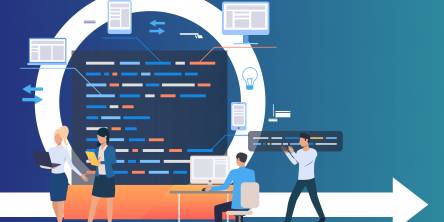Overcoming Financial Services Challenges through Legacy Application Modernization

In the ever-evolving financial services landscape, industry challenges are numerous and complex. From stringent regulations to rapidly advancing technology and changing consumer expectations, financial institutions face many obstacles. Looking at the financial services market, it becomes clear that companies in this sector operate in a highly regulated environment, with businesses subject to many challenges. Adhering to these regulations can be complex and costly. Then there are legacy applications — they cannot be easily adapted to this market's changing requirements, thus steamrolling a financial business' ability to protect its data, ensure compliance, and more. This is where legacy application modernization comes in!
However, embracing legacy application modernization can meet these challenges with innovative solutions that drive efficiency, compliance, and competitiveness. In this blog, we will explore the key challenges of the financial services sector and how legacy application modernization plays a pivotal role in overcoming them.
In this article, ladies and gentlemen, I will walk you through some of the main challenges for the financial services company that can be addressed by legacy application modernization.
What is Legacy Application Modernization?
It updates and improves a company's current software systems to make them more efficient and compatible with modern technologies. Legacy app modernization aims to enhance the performance, functionality, and maintainability of a company's software systems.
How Does Legacy App Modernization Help the Financial Services Market?
Legacy application modernization can help the sector address many of its challenges by updating and modernizing legacy systems, thus enhancing their agility and responsiveness to regulatory changes. Let us also take a closer look at the many challenges with which app modernization can help.
Key Challenges that Legacy Application Modernization Can Help the Financial Services Market With
- Outdated Systems: It is not hard to see that obsolete apps typically do not have the agility to help companies keep pace with the market's evolving requirements and that of customers. Legacy application modernization can help by either replacing or updating legacy systems, thus making them more conducive to integration with new technologies and services.
- Cost transformation: As you, I, and pretty much anyone even vaguely familiar with the concept of legacy apps know, legacy apps are expensive to maintain. Modernizing such apps helps streamline operations, cut down hardware and software maintenance costs, and optimize resource utilization, thus helping save money.
- Regulatory compliance: The financial services market is understandably subject to stringent regulations. Unfortunately, it can be hard to keep up with regulations with outdated systems since they may not quickly adapt to new standards for reporting, data security, customer protection, etc. Modernizing is a reliable way to integrate the required features for compliance.
- Lack of interoperability: In the world of financial services, it is imperative that systems can speak to one another to ensure smooth workflows at all times. Since outdated systems tend to lack the required interfaces and interoperability features, modernization helps by improving such systems' capabilities in terms of compatibility and integration.
- Market competition: The fact that the financial services market is intensely competitive is no secret. In such a market, innovation is critical for survival, and legacy app modernization helps with that by empowering organizations to develop new, innovative solutions quickly.
Final Words
The intense challenges that the highly regulated and competitive world of financial services faces are an undeniable reality. And legacy systems only impede companies' efforts to grow and succeed. App modernization, then, comes in as the perfectly transformative solution, helping financial services providers enhance their agility and responsiveness. If you, too, are ready to revamp your legacy apps, I suggest you start looking for a trusted provider who offers services for legacy application modernization.
Similar Articles
Unless you have been hiding in a cave somewhere, you would know and realize that the world is creating information at a stunning speed. While it is genuinely considered normal information that said data can now be turned into the groundwork of achievement for essentially any business in the present day and age.
Software development refers to the procedure of constituting and nourishing software applications. This provokes the utilization of many fundamentals and practices. Software development targets constitute structured, dependable, and beneficial software.
Designing a data warehouse is a strategic activity that builds the groundwork for strong data management and analytics capabilities within a business. In today's data-driven world, the systematic creation of a data warehouse is not only a technical requirement but also a critical step in harnessing the power of information for informed decision-making.
The integration of Internet of Things (IoT) technology into the construction and real estate sectors, which include buildings, infrastructure, homes, and businesses, is predicted to increase dramatically in the future. Despite this predicted expansion, the construction industry is behind other industries in terms of IoT adoption.
In this dynamic world of innovative and transformative technology, the use of Minimum Viable Product (MVP) has proven to be a winning strategy for success.
While monolithic applications may have waned in popularity during the era dominated by the cloud and microservices, interest is resurgent. Organizations, in considering their position on the application modularity spectrum, are now examining both the advantages and drawbacks of relying on microservices.
Data visualization is an indispensable tool that allows us to transform raw, and often unstructured data into insightful visuals, identify patterns, and communicate these insights to the wider audience and stakeholders.
For modern businesses to thrive, ensuring the effective management of inventory stands has become vitally important. Inventory management stands as a cornerstone of success. And the emergence of the Internet of Things (IoT) has introduced a new era of connectivity and efficiency across diverse industries.
Do you know what the following e-commerce companies have in common: Amazon, Walmart, eBay, and more? All of these e-commerce companies' apps make use of Java. Java is decidedly among the leading choices of programming language for e-commerce applications because it offers a world of benefits; for example, since Java code can be run on any platform with a Java Virtual Machine (JVM), users of e-commerce apps made with Java can access the said apps on a variety of devices.








